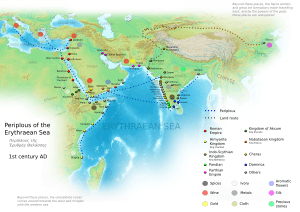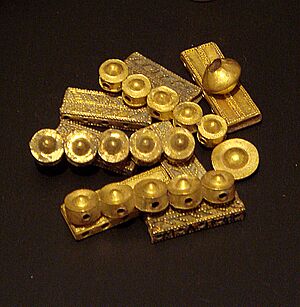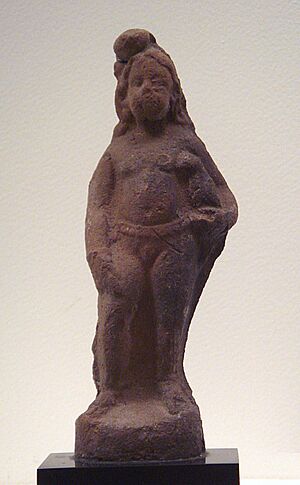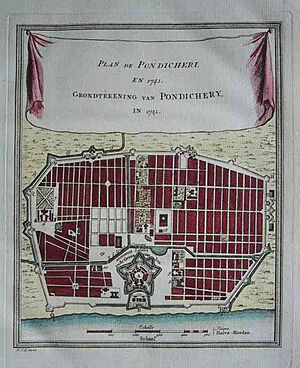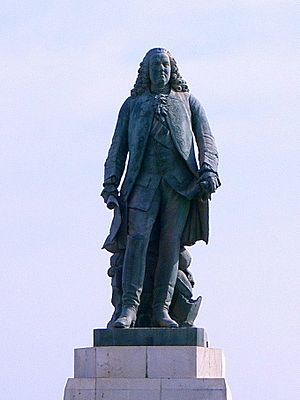History of Puducherry facts for kids
Puducherry, also known as Pondicherry, is a city on India's southeast coast. Its recorded history mostly begins when European powers like the Dutch, Portuguese, English, and French arrived. However, areas nearby, like Ariyankuppam and Villianur, which later became part of Puducherry, have much older histories.
Contents
Ancient Times in Puducherry
An ancient guide from the 1st century, called the Periplus of the Erythraean Sea, mentions a trading place named Poduke. Experts believe this was likely Arikamedu, which is now part of Ariyankuppam, just a short distance from modern Puducherry. This shows that Puducherry was an important stop for Roman trade with India. Roman pottery found there in the 1930s and later excavations confirmed it was a busy trading post in the 1st century AD.
Around the 4th century AD, the Puducherry area was part of the Pallava Kingdom. Over the next centuries, different powerful kingdoms ruled the region. The Cholas took control in the 10th century, followed by the Pandya Kingdom in the 13th century. After a brief period under Muslim rulers, the mighty Vijayanagara Empire ruled most of South India until 1638. Then, the Sultan of Bijapur took over the area.
European Influence in Puducherry
In 1674, the French East India Company set up a trading center in Pondicherry. This outpost grew into a major manufacturing hub and became the main French settlement in India for a long time.
Other European countries, like the Dutch and British, also wanted to trade with India. This led to wars in Europe that spread to India. The Dutch captured Puducherry in 1693 but gave it back to France in 1699 after a peace treaty.
The French expanded their control, acquiring Mahe in the 1720s, Yanam in 1731, and Karaikal in 1738. During the Anglo-French wars (1742–1763), Puducherry was often fought over. The British captured it in 1761, but the Treaty of Paris (1763) returned it to France.
In 1792, Venant of Durfort became the governor of Pondicherry. He worked to keep the region stable and maintain trade with other European powers.
The British took control of Puducherry again in 1793 during the French Revolution wars. They returned it to France in 1814. Even when the British ruled most of India by the late 1850s, they allowed the French to keep their settlements. So, Pondicherry, Mahe, Yanam, Karaikal, and Chandernagar remained part of French India until 1954.
The End of French Rule in India
After India gained independence from British rule in 1947, it wanted the French territories to join India too. It took seven years for Puducherry to officially become part of independent India. People had already started protesting for this goal much earlier.
Farmers in Karaikal protested against high land taxes in the late 1700s. Student protests in 1927 and 1930 also showed a desire for French rule to end. Important Indian leaders like Mahatma Gandhi and Jawaharlal Nehru visited Pondicherry and spoke to the people.
In the late 1930s, local groups called mahajana sabhas and trade unions started a Non-Cooperation Movement against the French government. During Second World War, Puducherry supported France with soldiers and supplies. The deaths of French-Indian soldiers caused more unrest.
In 1946, the French India Congress was formed to push for the merger of French territories with India. In 1948, the French People's Convention also wanted to merge with India. India's Prime Minister Jawaharlal Nehru was eager to unite these territories.
India and France agreed in 1948 that the people in French territories would choose their future. However, India later withdrew support for a public vote, fearing the outcome. Instead, an agreement was signed in June 1948, giving power to the people to decide. Local elections were held, and most elected pro-French representatives.
India continued to push for unification, promising special status and help for Puducherry. As the movement grew, even some pro-French leaders switched to supporting the merger. On March 18, 1954, members of the local council and mayors in Pondicherry and nearby areas declared their decision to merge with India without a vote. Other areas like Karaikal followed.
When the French governor tried to stop this, pro-merger groups began taking over villages. On the last day of March 1954, the Indian national flag was raised over the Nettapakkam police station. Many villages joined the pro-merger forces. In Karaikal, all local councils voted for merger.
After more talks, India and France announced a plan for the French settlements on October 13, 1954. Five days later, on October 18, 1954, elected members in Puducherry and Karaikal voted at Kizhur. Out of 178 voters, 170 chose to merge with India. Three days later, an agreement was signed in New Delhi to transfer the French territories to India.
A formal treaty was signed in May 1956 and approved by the French parliament in May 1962. On August 16, 1962, France officially gave full control of its territories to India. Pondicherry and the other areas like Karaikal, Mahe, and Yanam became the Union Territory of Puducherry from July 1, 1963.
Chandernagore Joins India
Under an agreement in June 1948, elections were held in Chandernagore. The Congress Karmaparishad won most seats. The new local assembly voted strongly to merge with India. India took control on June 9, 1952. Later, in 1954, Chandernagore became part of the Hoogly district in West Bengal.
Yanam's Freedom
Life became very difficult in Yanam after its mayor and other leaders voted for the merger. Many people, including the mayor, fled to nearby Indian areas. Police and hired guards from Yanam attacked these refugees on Indian soil. The refugees, led by Dadala Raphael Ramanayya, marched back into Yanam and took control. They raised the Indian National Flag and declared Yanam "liberated."
Mahe's Liberation
Following Yanam's example, in Mahe, a group called the Mahajana sabha, led by I.K. Kumaran, started protests. Hundreds of volunteers marched into Mahe to demonstrate. On July 16, 1954, Kumaran took over the administration from the French. This ended 224 years of French rule in Mahe.
Key Dates of Transfer
| Colony | Liberation | De facto transfer | Treaty of Cession | De jure transfer | Merger |
|---|---|---|---|---|---|
| Chandernagore | 2 May 1950 | 2 February 1951 | 9 June 1952 | 1 October 1954 | |
| Pondichéry | 1 November 1954 | 28 May 1956 | 16 August 1962 | 1 July 1963 | |
| Karikal | 1 November 1954 | 28 May 1956 | 16 August 1962 | 1 July 1963 | |
| Yanaon | 13 June 1954 | 1 November 1954 | 28 May 1956 | 16 August 1962 | 1 July 1963 |
| Mahé | 16 June 1954 | 1 November 1954 | 28 May 1956 | 16 August 1962 | 1 July 1963 |
French Governors of Puducherry
Over the centuries, many French officials governed Puducherry. These leaders, known as Commissaires or Gouverneurs Généraux, played a big role in the region's history. For example, François Martin was an early important governor. Later, Joseph François Dupleix was a well-known governor from 1742 to 1754. During these times, Puducherry was sometimes taken over by the British, but then returned to French control through peace treaties. This happened several times until the final transfer to India.


